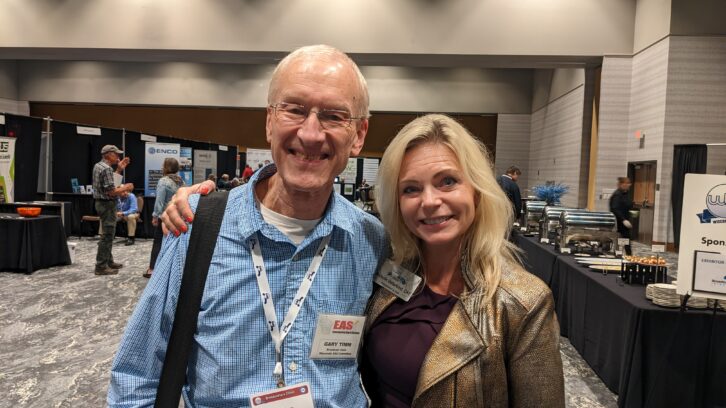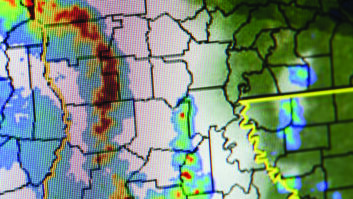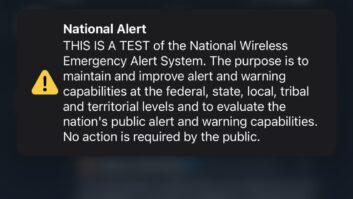Gary Timm recalls with pride that Wisconsin was the first state to file its required EAS plan with the FCC in 1996 — and it was submitted on a floppy disk.
The longtime broadcast chair of the Wisconsin State Emergency Communications Committee retired recently, ending a career steeped in public warning accolades including the inaugural Service Award from Wisconsin Emergency Management in 2022 and a Certificate of Commendation from the state governor in 2005.
Timm, 70, saw major changes in public warning throughout his 30 years as broadcast chair. The Emergency Broadcast System was succeeded by the Emergency Alert System, which in turn has been enhanced and is no longer just a daisy chain of radio stations cobbled together.
Timm retired from full-time broadcast engineering in 2010 after 37 years at Journal Broadcast Group in Milwaukee at WTMJ(AM) and WKTI(FM). He then worked part-time for several years as an alerts and warnings consultant with SRA International. And now he has stepped down from his SECC role, where his successor is Chris Tarr, group director of engineering for Magnum Media.
We asked Timm about changes in alerting, serving the EAS community, his broadcast memories and his commitment to volunteerism.
Radio World: What got you interested in EAS in the first place?
Gary Timm: I started with alerting duties in the 1970s at WTMJ radio in Milwaukee, where I worked my entire broadcast engineering career. When the state chair was ready to retire, I volunteered for the role.
It’s been a great ride, with just the finest cooperation from all levels of state government and our stellar Wisconsin broadcasters all along the way.
RW: Any specific highlights of serving in the public warning sector?
Timm: In 2011 as a FEMA contractor, I helped conduct the very first test of the Commercial Mobile Alert System, the predecessor of Wireless Emergency Alerts, from the New York City Emergency Operations Center. The test was a resounding success and our team was elated. It was one of the more exciting, cutting-edge moments in my life.
RW: What are you most proud of in your 30+ years as Wisconsin EAS Chair?
Timm: I would say getting our Amber Alert program off the ground in 2003. This year we are celebrating the program’s 20th anniversary with a ceremony in Madison, where I will be the EAS Chair Emeritus guest of honor.

RW: The FCC has made changes in EAS to move public warning forward. What are some of the more significant?
Timm: I was really happy to see the FCC adopt CAP prioritization, where EAS units receiving a legacy EAS message then check IPAWS for a CAP version and if found use that version.
For years we have been telling emergency managers that using IPAWS gets them more explanatory text in TV crawl messages, but that has only been true 50% of the time depending on whether the legacy EAS or IPAWS message arrives at the station first.
It will now assure alert originators that in the vast majority of cases their IPAWS message will be aired. Hats off to FCC for this move when it becomes effective Dec. 12, 2023.
RW: Any thoughts on what might be next in EAS that broadcasters should be watching for?
Timm: The FCC seems very focused on improving alerting to those with access and functional needs, and those not fluent in English. The recent CAP prioritization rule is an attempt to make EAS visual messages more descriptive for those with hearing loss.
In mid-February, the chairwoman issued a news release seeking information on multilingual WEA messages. I expect more FCC efforts regarding multilingual EAS messages as well. The problem is that those non-English messages need to be crafted by the alert originators, who have expressed issues having a translation service available 24/7 in a moment’s notice.
I suspect the FCC may need to work with FEMA on solving that dilemma, possibly with grant money or other innovative solutions, but it is definitely a valid need.
RW: You spent a long time working in broadcast engineering in Milwaukee radio and saw the technology evolve. What were those changes like?
Timm: There were so many advancements, but toward the end of my broadcast engineering career, I really missed the days when we used to build stuff. If you needed a relay panel, switching system or other gadget, you built it from scratch. Now everything is off the shelf.
My greatest gadgets were things we used every day, and it was rewarding to see them work as intended.
RW: Did you have mentors to help you at the beginning of your broadcast career?
Timm: My boss at WTMJ(AM) was Jim Wulliman. He needs no introduction to most everyone in the broadcast engineering community who know his legendary contributions to SBE and its certification program. He was a great inspiration and example to all of us.
Nels Harvey, a WMVS(TV) engineer at Milwaukee Area Technical College, gave me my first broadcasting job as I finished school at WYLO — “Way-Low,” at 540 kHz. He was a patient and talented mentor, back in the days of 30-minute transmitter readings and the daily hike out to the tower doghouses.
RW: You were a longtime AM guy. We have reported on automakers dropping AM broadcast radio from EVs and other cars. How would you respond to the auto industry and others who say broadcast is playing a smaller and less important role in alerting?
Timm: While this is scary for those of us in the EAS community, the public veering away from broadcast radio even when it is available is a reality. As Radio World has noted, the automotive industry is making attempts to access emergency information via other means, such as IPAWS alerts directly into the vehicle infotainment system.
All we can do as broadcasters is to continue to offer EAS alerting to our audiences and double our efforts to make our graphics and visual content in the automobile as compelling as possible to compete with the many other offerings available.
The disappearance of AM radio in cars should be a major concern for FEMA, as they have spent millions of dollars on Primary Entry Point and so-called last resort stations, which are almost all high-power AM stations. Perhaps FEMA will put their weight behind the efforts of some senators looking to require AM radios in cars.
RW: What would be your advice to your successor and other state EAS chairs?
Timm: Build a strong SECC. Consciously bring in younger members to build in longevity, and have SECC members from all stakeholder communities: state broadcasters association, state emergency management agency, NWS, etc.
Involve your EAS participants. We have radio station and TV station representatives on our SECC, and the vice chair is from the cable TV industry. In 1996, we held an EAS Summit for participants to select the RMT times our SECC uses. We have continued to get great support from our EAS participants over the years.
Doing all these things, I left my EAS chair position with total confidence that the SECC is in good hands, especially with Chris Tarr succeeding me as EAS chair. We are so lucky to have him here in Wisconsin.
RW: You signed off on your message to the EAS community informing them of your decision to step aside with best wishes: “God speed to you all in keeping IPAWS and our EAS strong down the road.” EAS and public warning really have been your life’s work.
Timm: This has been a great experience. I’ll just repeat what I said in my message. It’s been a privilege to volunteer my service all these years for the people of Wisconsin, and the EAS on a national basis. I will truly miss my EAS colleagues and friends, and thanks to them all for the support and rewarding relationships.
RW: Volunteerism will remain important to you even in full retirement?
Timm: I’ve already started working with the Lake Park Friends, who help maintain the expansive lakefront park near my home in Milwaukee that was designed by Frederick Law Olmsted, designer of New York City’s Central Park. This past summer we celebrated his 200th birthday with a big park-wide party.
I accepted the Service Award from Wisconsin Emergency Management in 2022 by ending with this: Throughout life, and even in retirement, consider utilizing your expertise by volunteering. It is truly rewarding.










